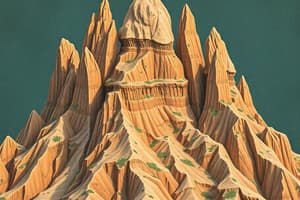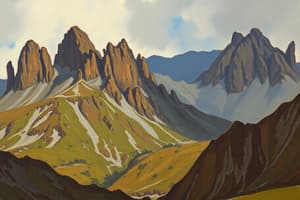Podcast
Questions and Answers
Which landform is primarily a result of glacier movement?
Which landform is primarily a result of glacier movement?
- U-shaped valley (correct)
- Delta
- Lagoon
- Sand dune
What process contributes to the eventual decay of solid particles?
What process contributes to the eventual decay of solid particles?
- Chemical reactions dissolving minerals (correct)
- Wind erosion transporting rocks far away
- Biological activity facilitating nutrient cycling
- Physical breakdown caused by volcanic eruptions
How do ice sheets shape the landscape?
How do ice sheets shape the landscape?
- By advancing upon and retreating from the land (correct)
- By causing volcanic eruptions
- By causing earthquakes
- By leading to excessive erosion
What process contributes to the creation and redistribution of moraine deposits?
What process contributes to the creation and redistribution of moraine deposits?
Which mechanism is NOT involved in soil formation and rock decay?
Which mechanism is NOT involved in soil formation and rock decay?
What is responsible for driving the motion of rigid lithospheric plates according to plate tectonics?
What is responsible for driving the motion of rigid lithospheric plates according to plate tectonics?
Which geological process is responsible for rocks and sediments breaking down due to natural forces like wind, water, ice, gravity, and heat?
Which geological process is responsible for rocks and sediments breaking down due to natural forces like wind, water, ice, gravity, and heat?
What is the result of deposition?
What is the result of deposition?
In the context of landforms, what role do glaciers play during the deposition process?
In the context of landforms, what role do glaciers play during the deposition process?
Which geological process involves matter settling from flowing water, air, or melting ice to gradually build up over time?
Which geological process involves matter settling from flowing water, air, or melting ice to gradually build up over time?
How do rivers contribute to the erosion process?
How do rivers contribute to the erosion process?
What overarching theme ties erosion, deposition, weathering, and glacial processes together when understanding landforms?
What overarching theme ties erosion, deposition, weathering, and glacial processes together when understanding landforms?
Flashcards are hidden until you start studying
Study Notes
Landforms and Their Evolution
Understanding landforms—the unique shapes and features of Earth's surface—requires exploring how they came into being through various geological processes. This journey delves deeper into four key aspects: erosion, deposition, weathering, and glacial processes, all intertwined with the overarching theme of plate tectonics. Let's begin our expedition by examining each component and their role in shaping our planet.
Erosion
Erosion is the process whereby rocks and sediments break down due to natural forces like wind, water, ice, gravity, and heat. These agents relentlessly chip away at landforms until new ones emerge. For instance, rivers carve valleys called gorges by continuously wearing them downwards, smoothing rough edges, while sandy coastlines evolve through waves breaking and depositing material. As landscapes change, so too does topography create diverse environments fostering life in every corner.
Deposition
The opposite of erosion, deposition entails matter accumulating to form new landforms. When particles settle from flowing water, air, or melting ice, these deposits gradually build up over time. Deltas result when river sediment collects near its mouth forming fertile plains, whereas glaciers leave behind moraines made of stones dragged along during movement. Sand dunes and beach ridges also arise via sediment accretion under specific conditions such as prevailing winds.
Weathering
This concept refers to mechanisms that progressively disintegrate rock materials without transporting them far. Chemical reactions dissolving minerals or physical breakdown caused by freezing and thawing cycles both contribute to soil formation and the eventual decay of solid particles. Biological activity further contributes to weathering by facilitating nutrient cycling through microorganisms, animals, and plants, ultimately converting rocks into organic compounds.
Glacial Processes
Ice sheets play a significant role in shaping the landscape, as they advance upon and retreat from the land, leaving permanent marks. Ice flow causes scouring and abrasion, exposing bedrock beneath once-buried strata; this results in features such as U-shaped valleys and drumlins. Melting ice releases large quantities of water that turns into streams, which continue to shape surrounding areas. Additionally, glacier movement contributes to the creation and redistribution of moraine deposits.
Plate Tectonics
Plate tectonics presents another perspective essential for understanding landform development, given it dictates continental drift and subsequent collisions leading to mountain ranges and ocean basin formations. At the heart of this theory lies the motion of rigid lithospheric plates comprising Earth's crust and upper mantle driven by convection currents deep within our planet.
This summary offers only the barest outline of complex interactions governing landform evolution. However, mastering these principles provides valuable insight into our living world's enduring transformation. By appreciating earthly dynamics, we can comprehend our past and potentially predict future changes, thereby enriching knowledge fundamental to preserving this beautiful blue marble we call home.
Studying That Suits You
Use AI to generate personalized quizzes and flashcards to suit your learning preferences.




